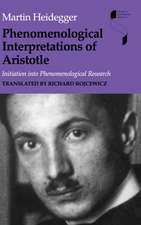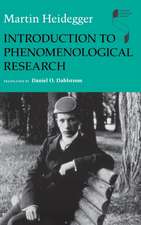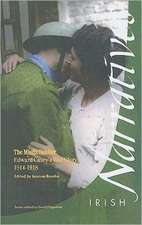Imagining, Second Edition – A Phenomenological Study
Autor Edward S. Caseyen Limba Engleză Paperback – 21 oct 2000
A Phenomenological Study
Second Edition
Edward S. Casey
A classic firsthand account of the lived character of imaginative experience.
"This scrupulous, lucid study is destined to become a touchstone for all future writings on imagination." Library Journal
"Casey s work is doubly valuable for its major substantive contribution to our understanding of a significant mental activity, as well as for its exemplary presentation of the method of phenomenological analysis." Contemporary Psychology
..". an important addition to phenomenological philosophy and to the humanities generally." Choice
..". deliberately and consistently phenomenological, oriented throughout to the basically intentional character of experience and disciplined by the requirement of proceeding by way of concrete description.... Imagining] is an exceptionally well-written work." International Philosophical Quarterly
Drawing on his own experiences of imagining, Edward S. Casey describes the essential forms that imagination assumes in everyday life. In a detailed analysis of the fundamental features of all imaginative experience, Casey shows imagining to be eidetically distinct from perceiving and defines it as a radically autonomous act, involving a characteristic freedom of mind. A new preface places Imagining within the context of current issues in philosophy and psychology.
use one Casey bio for both Imagining and Remembering]
Edward S. Casey is Professor of Philosophy at the State University of New York at Stony Brook. He is author of Getting Back into Place: Toward a Renewed Understanding of the Place-World (Indiana University Press) and The Fate of Place: A Philosophical History.
Studies in Continental Thought John Sallis, general editor
Contents
Preface to the Second Edition
Introduction The Problematic Place of Imagination
Part One: Preliminary Portrait
Examples and First Approximations
Imagining as Intentional
Part Two Detailed Descriptions
Spontaneity and Controlledness
Self-Containedness and Self-Evidence
Indeterminacy and Pure Possibility
Part Three: Phenomenological Comparisons
Imagining and Perceiving: Continuities
Imagining and Perceiving: Discontinuities
Part Four: The Autonomy of Imagining
The Nature of Imaginative Autonomy
The Significance of Imaginative Autonomy"
Librarul mai recomandă
Preț: 238.32 lei
Nou
Puncte Express: 357
Preț estimativ în valută:
45.60€ • 47.74$ • 37.73£
45.60€ • 47.74$ • 37.73£
Carte tipărită la comandă
Livrare economică 05-19 aprilie
Preluare comenzi: 021 569.72.76
Specificații
ISBN-13: 9780253214157
ISBN-10: 0253214157
Pagini: 272
Dimensiuni: 156 x 233 x 20 mm
Greutate: 0.41 kg
Ediția:2
Editura: MH – Indiana University Press
Locul publicării:United States
ISBN-10: 0253214157
Pagini: 272
Dimensiuni: 156 x 233 x 20 mm
Greutate: 0.41 kg
Ediția:2
Editura: MH – Indiana University Press
Locul publicării:United States
Cuprins
Preface to the Second Edition
Introduction The Problematic Place of Imagination
Part One Preliminary Portrait
1. Examples and First Approximations
2. Imagining as Intentional
Part Two Detailed Descriptions
3. Spontaneity and Controlledness
4. Self-Containedness and Self Evidence
5. Indeterminacy and Pure Possibility
Part Three Phenomenological Comparisons
6. Imagining and Perceiving: Continuities
7. Imagining and Perceiving: Discontinuities
Part Four The Autonomy of Imagining
8. The Nature of Imaginative Autonomy
9. The Significance of Imaginative Autonomy
Introduction The Problematic Place of Imagination
Part One Preliminary Portrait
1. Examples and First Approximations
2. Imagining as Intentional
Part Two Detailed Descriptions
3. Spontaneity and Controlledness
4. Self-Containedness and Self Evidence
5. Indeterminacy and Pure Possibility
Part Three Phenomenological Comparisons
6. Imagining and Perceiving: Continuities
7. Imagining and Perceiving: Discontinuities
Part Four The Autonomy of Imagining
8. The Nature of Imaginative Autonomy
9. The Significance of Imaginative Autonomy
Recenzii
Casey's work is doubly valuable--for its major substantive contribution to our understanding of a significant mental activity, as well as for its exemplary presentation of the method of phenomenological analysis. --Contemporary Psychology
. . . an important addition to phenomenological philosophy and to the humanities generally. --Choice
This scrupulous, lucid study is destined to become a touchstone for all future writings on imagination. --Library Journal
. . . deliberately and consistently phenomenological, oriented throughout to the basically intentional character of experience and disciplines by the requirement of proceeding by way of concrete description. . . . an exceptionally well-written work. --International Philosophical Quarterly
. . . an important addition to phenomenological philosophy and to the humanities generally. --Choice
This scrupulous, lucid study is destined to become a touchstone for all future writings on imagination. --Library Journal
. . . deliberately and consistently phenomenological, oriented throughout to the basically intentional character of experience and disciplines by the requirement of proceeding by way of concrete description. . . . an exceptionally well-written work. --International Philosophical Quarterly
Descriere
A classic firsthand account of the lived character of imaginative experience.


















